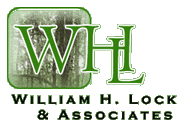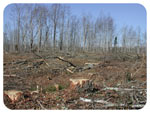 |
|
Timber Management
Release spraying is usually done within 2-5 years of a stand's establishment. The area is sprayed with a selective herbicide which controls the unwanted vegetation. This allows for the primary trees to increase in growth and development. Precommercial thinning is conducted on a stand when the number of stems is too great to allow for maximum growth potential. Either too many trees were initially planted or too many natural seedlings created a high level of trees per acre. This can be accomplished by mechanical means, such as a small dozer or chopper arrangement. In hardwood stands, hand crews can be used to release the selected trees. This is called a "crop tree release". Pulpwood thinning is generally conducted in pine stands and is the removal of a certain percentage of stems which will allow the remaining "crop" trees to grow faster and with better form. In pine stands, basal area measurements are used to estimate the removal of certain stems to promote the remaining trees' growth. A well conducted pulpwood thinning provides a small income for the landowner while enhancing the remaining stand and promoting the future growth of the remaining "crop" trees. Prescribed burning is a useful tool for controlling unwanted hardwoods in a pine stand. Conducted during the winter months, the fire kills the thin bark on the hardwoods. This allows for the increased growth of the pines. Wildlife species benefit due to the increase of forest floor herbaceous plants and browse sources. Please contact William H. Lock & Associates, Inc. at (336) 632-9088 or whlock@whlock.com for more information on Timber Management activities. |
|
|||||||||||||||||
Site design by KMC Consulting, Inc.



 Timber Management is the actual growing of the selected trees/stands to their optimal use. Intermediate management techniques include release spraying for unwanted vegetation control, precommercial thinning, pulpwood thinning, and prescribed burning. These are all silvicultural treatments that can be provided during the rotation of the managed stand. William H. Lock & Associates, Inc. (
Timber Management is the actual growing of the selected trees/stands to their optimal use. Intermediate management techniques include release spraying for unwanted vegetation control, precommercial thinning, pulpwood thinning, and prescribed burning. These are all silvicultural treatments that can be provided during the rotation of the managed stand. William H. Lock & Associates, Inc. (